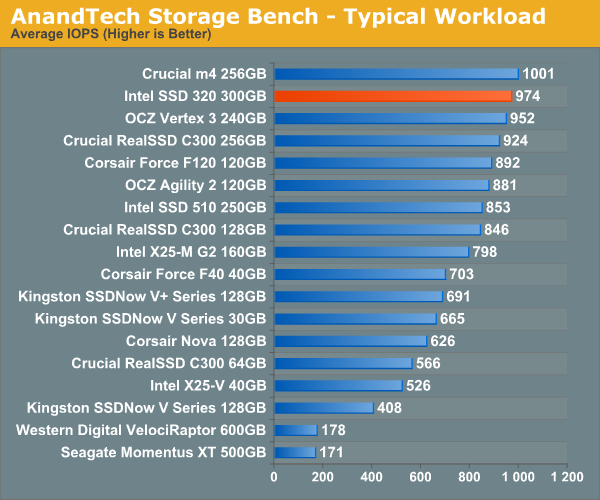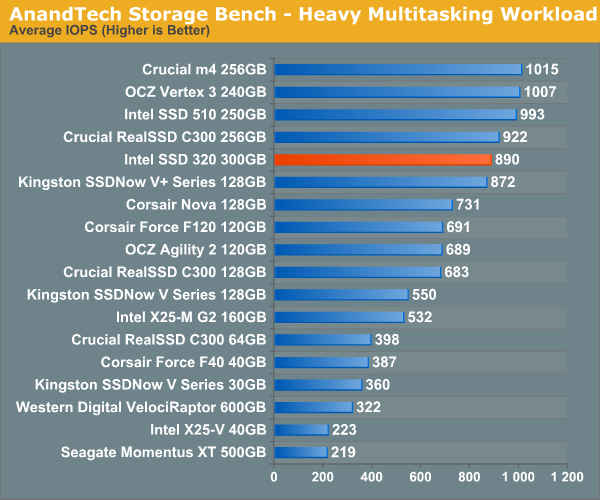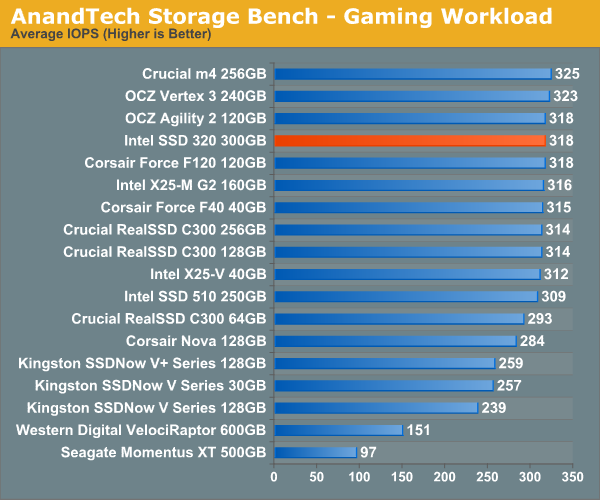The Intel SSD 320 Review: 25nm G3 is Finally Here
by Anand Lal Shimpi on March 28, 2011 11:08 AM EST- Posted in
- IT Computing
- Storage
- SSDs
- Intel
- Intel SSD 320
AnandTech Storage Bench 2010
To keep things consistent we've also included our older Storage Bench. Note that the old storage test system doesn't have a SATA 6Gbps controller, so we only have one result for the 6Gbps drives.
The first in our benchmark suite is a light/typical usage case. The Windows 7 system is loaded with Firefox, Office 2007 and Adobe Reader among other applications. With Firefox we browse web pages like Facebook, AnandTech, Digg and other sites. Outlook is also running and we use it to check emails, create and send a message with a PDF attachment. Adobe Reader is used to view some PDFs. Excel 2007 is used to create a spreadsheet, graphs and save the document. The same goes for Word 2007. We open and step through a presentation in PowerPoint 2007 received as an email attachment before saving it to the desktop. Finally we watch a bit of a Firefly episode in Windows Media Player 11.
There’s some level of multitasking going on here but it’s not unreasonable by any means. Generally the application tasks proceed linearly, with the exception of things like web browsing which may happen in between one of the other tasks.
The recording is played back on all of our drives here today. Remember that we’re isolating disk performance, all we’re doing is playing back every single disk access that happened in that ~5 minute period of usage. The light workload is composed of 37,501 reads and 20,268 writes. Over 30% of the IOs are 4KB, 11% are 16KB, 22% are 32KB and approximately 13% are 64KB in size. Less than 30% of the operations are absolutely sequential in nature. Average queue depth is 6.09 IOs.
The performance results are reported in average I/O Operations per Second (IOPS):

If we strip 6Gbps out of the equation completely, the SSD 320 does very well in our old light workload. You're looking at performance that's at the top of the pack from the mainstream offering.
If there’s a light usage case there’s bound to be a heavy one. In this test we have Microsoft Security Essentials running in the background with real time virus scanning enabled. We also perform a quick scan in the middle of the test. Firefox, Outlook, Excel, Word and Powerpoint are all used the same as they were in the light test. We add Photoshop CS4 to the mix, opening a bunch of 12MP images, editing them, then saving them as highly compressed JPGs for web publishing. Windows 7’s picture viewer is used to view a bunch of pictures on the hard drive. We use 7-zip to create and extract .7z archives. Downloading is also prominently featured in our heavy test; we download large files from the Internet during portions of the benchmark, as well as use uTorrent to grab a couple of torrents. Some of the applications in use are installed during the benchmark, Windows updates are also installed. Towards the end of the test we launch World of Warcraft, play for a few minutes, then delete the folder. This test also takes into account all of the disk accesses that happen while the OS is booting.
The benchmark is 22 minutes long and it consists of 128,895 read operations and 72,411 write operations. Roughly 44% of all IOs were sequential. Approximately 30% of all accesses were 4KB in size, 12% were 16KB in size, 14% were 32KB and 20% were 64KB. Average queue depth was 3.59.

Crank up the workload and the 320 falls a bit behind the rest of the competitors. Last year's heavy multitasking workload is nothing compared to what we introduced earlier this year, so it's still pretty light by comparison but it's clear for normal usage the 320's 3Gbps performance is quite good.
The gaming workload is made up of 75,206 read operations and only 4,592 write operations. Only 20% of the accesses are 4KB in size, nearly 40% are 64KB and 20% are 32KB. A whopping 69% of the IOs are sequential, meaning this is predominantly a sequential read benchmark. The average queue depth is 7.76 IOs.











194 Comments
View All Comments
bji - Monday, March 28, 2011 - link
But don't they? I am pretty sure that the listed price for a 160 GB drive is about the same as I paid for my 80 GB G2 a year ago. Maybe these prices are higher than current prices on the older generation drives but you really should compare products at the same point of their life cycle to be fair. The G3 is half the cost that the G2 was at launch (actually less than half if I am remembering correctly) and in a year when they are at a later point in the product life cycle they wil be half as expensive or less per GB than the G2 is at the same point of its life cycle.qwertymac93 - Monday, March 28, 2011 - link
I think we all knew it wouldn't be as fast as The new sandforces, but i didn't expect it to be so expensive. i guess intel figured people will buy it just because it's intel. Not me though, I'm waiting for next gen(<25nm) ssd's before i make the plunge, i want sub $1 per gig.A5 - Monday, March 28, 2011 - link
Oh well - $170 for 120GB is still pretty good.AnnonymousCoward - Sunday, April 3, 2011 - link
G2 120GB is $230.aork - Monday, March 28, 2011 - link
"That works out to be 320GB of NAND for a drive whose rated capacity is 300GB. In Windows you'll see ~279GB of free space, which leaves 12.8% of the total NAND capacity as spare area."Actually you only see 279 GB of free space in Windows because Windows displays in GiB (2^30 bytes), not true GB (10^9 bytes). In truth, you are only getting the expected 6.25% of the total NAND capacity as spare area.
Stahn Aileron - Monday, March 28, 2011 - link
Flash storage is, as far as I know, always treated as binary multiples, not decimal. SSD drive manufacturers take advantage of the discrepancy between the OS's definition and the HD manufacturers' definition of storage units (GiB - 2^(x*10) - vs GB - 10^(x*3)) to help cover the spare area.It also helps keep everything consistent within the storage industry. Can you imagine the fallout from having a 300GB SSD actually being 300GiB vs an "identically sized" 300GB HDD reporting only 279GiB? If the consumers don't get pissy about that, I'm positive the HDD manufacturers would.
Mr Perfect - Monday, March 28, 2011 - link
Yeah, disappointing really. The switch to SSDs would have been a golden opportunity for drives to format to what the label says. Oh well.Taft12 - Monday, March 28, 2011 - link
Marketing would never allow that. We're not going back to binary measures of storage ever again :(Zan Lynx - Monday, March 28, 2011 - link
And why would we? RAM is the only thing that was ever calculated in powers of 2. Ever.CPU MHz? 10-base.
Network speed? 10-base.
Hard drive capacity? Always 10-base. Since forever!
Making Flash size in base-2 would introduce a new exception, not restore any wondrous old measurement system.
If the label says 300 GB and the box contains 300,000,000,000 bytes, then it does contain exactly what was advertised. Giga as a prefix has always meant 1 billion. Gigahertz? 1 billion cycles per second. Gigameter? 1 billion meters. 1 gigaflops? 1 billion floating point operations per second.
jwilliams4200 - Monday, March 28, 2011 - link
Well said, Zan. I thought that almost everyone knew this, but it is disappointing to see Anand still using the wrong units in his reviews and tables. Windows reports sizes in GiB, but incorrectly labels it GB. Unfortunately, Anand makes the same mistake. Sad.